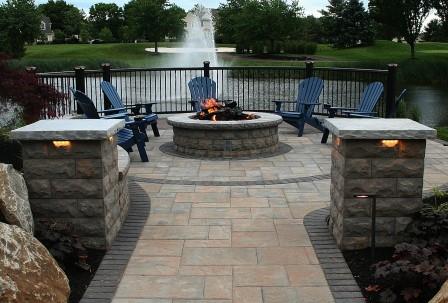What You Need To Know Before Fencing In A Yard
 Fencing in a yard seems like a simple project, right? Just hammer in a few posts, attach your fencing, and there you go. Well, that’s one way of doing it ... but it’s not the smartest.
Fencing in a yard seems like a simple project, right? Just hammer in a few posts, attach your fencing, and there you go. Well, that’s one way of doing it ... but it’s not the smartest.
Careful planning will save you tons of time, money, and hassle once you actually install your fence. I talked with Joe Raboine, Director of Belgard Residential Hardscapes, about what you must research before fencing in your yard... and a few things to watch out for.
Bottom line, warns Joe, is to “make sure you don’t do anything that will cost money later ... or have to be replaced!”
Laws and Regulations
Ensure your plans comply with local regulations. Your homeowners association is the place to start; most require an architectural review before approving new fence plans. Interestingly, Joe points out, “The city will usually defer to the HOA.”
If a permit is necessary for fence installation in your town, which your local landscapers are most likely familiar with, have that in hand before work begins. And find out whether underground utility pipes or cables run where you plan to dig.
Property Line
Determine your exact property line so you don’t accidentally install the fence on your next door neighbor’s turf. Refer to the plat map (if it’s less than 5 years old) or hire a surveyor. Local law might specify an additional setback of several inches to one foot.
Ground Condition
Joe comments, “Soil can play a big part in your fence planning. With new construction, you want to make sure the soil has settled. Otherwise, it should be thoroughly compacted.
“Beyond that, depending on the region of the country, you may need to reinforce the fenceposts. If the soil is very solid, like a heavy clay, often you can just pack it around the posts. But when it’s really sandy, you may have to use Sonotubes ™ filled with concrete to keep the sand from collapsing while you prepare to set the posts.
“In some areas, you’ll run into bedrock or boulders, which may require drilling or bringing in special equipment. When you get fencing quotes, discuss how that’s going to be handled.”

Materials
Modern fencing options include natural wood, composite, vinyl, aluminum, steel, chain link, wrought iron, and bamboo. (Read more about fence materials here.)
Four essential factors will help narrow your choice:
- purpose: privacy, secure children's play area, keeping animals in (or out), etc.
- budget
- taste and style
- amount of maintenance you’re willing to put into the finished product: eg, painting a wood fence
To illustrate: Though chain link is a cheap way of fencing in a yard, it may clash with the style of your home ... and doesn’t quite cut it as privacy fencing or a noise barrier.

Landscaping
Plan a fence that will work with your landscape and garden hardscape (existing or future). Consider whether you’d like to bring in heavy equipment, perhaps to pour a concrete patio. That should obviously be done before you have the fence installed. While your working on your yard, it may be prudent to follow steps to get a green lawn now to prepare your lawn for the summer when you’re going to use it the most.
Talk with your lawn sprinkler company to decide whether equipment will have to be repositioned. You do not want your new fence to be in the path of the lawn sprinkler spray.
Openings
How many gates will you need? Count on installing two minimum or possibly more -- for example, if your driveway will pass through the fence. At least one opening should be wide enough for outdoor necessities like garbage cans or snow blowers.

Special Features
Fence columns are trendy these days, according to Joe Raboine, for decorative purposes and to hold lighting. Joe advises you to plan the lighting design out carefully with your fencing company for the best-looking results.
Also popular are trellises or vertical gardens incorporated into the fence. This not only softens your fence’s appearance, but also supplies you with fresh vegetables or flowers. Especially suitable for new houses with smaller lots.

Fencing in a Yard -- Must-Know Numbers
- Cost for fencing in a yard: $1-45 per linear foot depending on type of material (not including labor).
- Cheapest fence material: barbed wire and electric (invisible) fencing both start at $1 per linear foot.
- Priciest fence material: composite such as Trex ™; upscale styles cost as much as $45 a linear foot.
- Average cost of fencing permit: $40.
- Average cost of land survey: $500.
- Fence height: generally 3’ limit for front yard; 6’ elsewhere on your property (pool fences have special regulations). Sometimes there’s a 30” minimum height. Confirm with your local building authority.
- Fencepost spacing: maximum 8’ apart.
- Posthole depth: at least 3’ in cold climates (6” below frostline).
- Gate width: 36” for a person walking and/or using a mobility device. 48+” for lawn equipment.
- One-call number to phone before digging: 811.
Laura Firszt writes for networx.com.
Looking for a Pro? Call us (866) 441-6648

Fencing Average Costs
Fence Contractors Experiences

Tree Removal So Fast And Efficient It Didn’t Even Wake Our Newborn

The Best Contractor: Prompt, Accurate And Ready For The Unexpected








